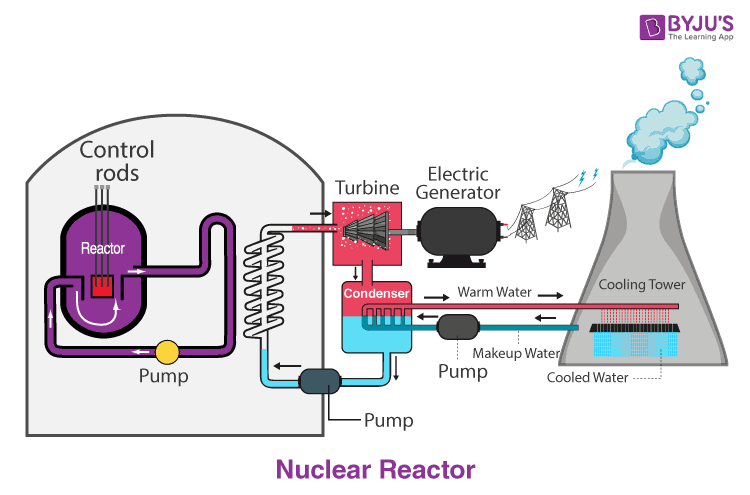
The moderator and coolant flows between the fuel elements (or rods) moderating the neutrons and carrying away the heat. The fissile material is encased in a solid cladding, made of Zircalloy (alloy of zirconium, having low capacity to absorb neutrons), to contain both the fuel and the resulting fission products and keep then from escaping into the moderator, coolant, or anywhere outside the cladding.

The fuel elements contains the fissile material, typically uranium or plutonium, which is used as the fuel to undergo fission and provide the nuclear energy. To produce energy, a nuclear reactor contains several major components: fuel elements (or rods), control rods, and coolant/moderator, besides the vessel itself containing everything. They serve the purpose of converting “nuclear energy” to heat. The opposite of a nuclear explosion, nuclear reactors are the controlled release of fission energy. However, in a nuclear reactor, energy is being produced at a controlled, constant rate a nuclear explosion is unlikely to occur. This rapid release of nuclear energy causes an explosion. In uncontrolled reactions, neutrons escape too quickly to maintain a chain reaction. A great example of this phenomenon would be a nuclear bomb. When one mass of U-235 exceeds the mass of U-235 that is large enough to hold down a chain reaction, also known as critical mass, an explosion occurs. An explosion could only occur if the reaction becomes uncontrolled. Note here Uranium 235 is used because it has a fairly large nucleus which facilitates the process of fission. During each U235/92 fission, 2.5 neutrons are released on average. In today's nuclear reactors, Uranium-235 is commonly used. According to Einstein's equation \(E=mc^2\), the small amount of missing mass is converted into a large amount of energy.Ī chain reaction occurs when the neutrons released in fission collide with at least one other nuclei, causing the fission of another nuclei. The mass of these products is less than the original mass. Nuclear fission is the process in which the nucleus of an atom is split, forming nuclei of lighter atoms and neutrons. Generator: it converts the mechanical energy into electrical energy.\) Therefore the heat energy is converted into mechanical energy in a turbine. Turbine: the turbine rotates due to the heat. Moderator: to decrease the speed of the fast moving neutrons formed during the fission.Ĭontrol rods: used to control the reaction or to stop the chain reaction.Ĭoolant: to absorb the heat produced by fission. The main components of a nuclear reactor are:įuel: the fissionable material used in the reaction. Inside a nuclear reactor the heat produced by nuclear reaction is converted into electricity by the means of a generator. Then by means of a pump the water is pumped back into the heat exchanger. The condenser converts the steam into water. For that the steam from the turbine is passed on to a condenser. The steam from the turbine should be converted back into water, so that it can be reused for the reaction.

Components of nuclear fission reactor generator#
When the high pressure steam reaches the turbine, the turbine rotates due to the high pressure.ĭue to the rotation of the turbine the generator will produce electricity. Turbine is a mechanical component which is coupled to the generator. The high pressure steam from the heat exchanger is passed on to the turbine. The heat exchanger is again connected to the steel vessel.

Inside the heat exchanger we have liquid sodium as coolant. Thus heat is transferred to the heat exchanger by means of a pump. When the reaction takes place a large amount of heat is produced. They are used to control the nuclear reactions. In between the fuel rods we have the control rods. Generally we use uranium-235 ($$), plutonium, thorium etc. These rods are the fissionable materials used for the reactions. It is inside this steel vessel where the nuclear reaction actually takes place. In a nuclear reactor, firstly we have a concrete chamber inside the chamber we have a steel vessel. The labeled diagram of a nuclear reactor is given above.


 0 kommentar(er)
0 kommentar(er)
